
In the Supertree Grove: The highest tree has a rooftop observatory. You can also see the elevated Skyway.
16 February Singapore
I had a window seat on the Airbus A320 as it took to
the night skies of Mumbai at 1:50 a.m. for a flight that would last about 5½
hours. IndiGo has a good reputation for on-time service and low fares, plus a
checked bag and drinking water are free; food costs extra but I skipped that
because I’m not one for dining in the wee hours. I paid $171.88 for the flight,
which was very cheap for the distance. At sunrise I could see northern Sumatra
in the distance to the west and many cargo ships in Malacca Strait below. The
plane flew over a bit of Malaysia near Kuala Lumpur before turning out to sea
again and making an approach to Singapore’s Changi Airport on the east end of
the island. On arrival at immigration I was surprised to find no lines at all!
That normally doesn’t happen at airports. Perhaps the ban on tourists from China
has left the airport unusually quiet. Immigration did ask to see my onward
ticket, which I had on my phone. Changi Airport is famous for its architecture
and amenities, but I didn’t take time to explore today. After exiting customs, I
found an ATM and cashed up with S$500 (US$360.14; one Singapore dollar is worth
US 72 cents). I had been advised that it’s easiest to get a SIM at the airport,
and did so with an M Card at S$30 for 12 days of service with lots of data,
local calls, SMSs and a handy 50 minutes of international calls. The same
counter also sold me a S$10 pre-paid EZ-Link transit card, though half of that
was a non-refundable deposit for the card. Outside I tried for a Grab taxi and
one came right away and took me to my Airbnb place a little west of the center
for S$19.
I had last come to Singapore way back in late 1981 when I flew
in from Indonesia, cycled up the east coast of Malaysia, flew from Kota Bharu to
Penang (The interior of northern Malaysia was considered too dangerous to cycle
across.), cycled the west side of Malaysia back to Singapore, then flew back to
Indonesia. On my first arrival I found Singapore a very exciting place after 5½
months of travels in the wilds of Solomon Islands, Papua New Guinea, and
Indonesia! The city’s diverse cultures entranced me as did witnessing the
frenetic Thaipusam (pronounced ‘tai-poo-sam’) festival by the Tamil community to
honor Lord Murgan, the Hindu god of war and a son of Shiva, with facial and
tongue piercing and other forms of self mutilation. Unfortunately Singapore’s
hotels and even the YMCA had sky-high prices then and the only place I could
afford was an illegal hostel that rented out nightly floor space. Nowadays
hotels still charge an arm and a leg, but many proper hostels have emerged.
However for a bit more than a hostel bed I arranged an Airbnb “Small but Cozy
Private Room” in a little apartment off Jalan Bukit Merah with a young woman and
her boyfriend for about US$28/night. There’s a well-mannered cat here too, but
she’s not allowed in the guest room. Last month my host had gone to Hainan
Island in China for a holiday, but the coronavirus broke out and all the
restaurants closed, so not a fun time. She was able to return to Singapore, then
undertook a 14-day self-quarantine, which she completed before my arrival. I
wandered about the neighborhood of high-rise apartment buildings and bought
snacks and a hefty Sunday edition of the Straits Times newspaper. A little
thunderstorm came through in late-afternoon on an otherwise partly cloudy day.
Life in Singapore has many advantages, such as drinkable tap water, smooth
roads, drivers that stop for pedestrians, tidiness, and high-speed wi-fi—all
relatively unknown in India! On the other hand, cyclists face heavy traffic, a
lack of paved shoulders, and few bike paths, so it’s unlikely I’ll ever cycle
here again. For a guidebook I have Lonely Planet’s “Malaysia, Singapore &
Brunei” (13th ed.; 2016). Now I’m looking forward to 11 days of sightseeing
here!
17 February Singapore
On a fine tropical day I set out for
Gardens by the Bay https://www.gardensbythebay.com.sg/ which might be the city’s
most famous sight. You have probably seen photos of the iconic giant man-made
‘trees’ of this enormous botanical garden, which includes two giant greenhouses
and a host of specialized gardens, exhibits, and artworks. It’s a place one
could wander for most of the day—and night too if one wishes—as the outdoor
gardens are open an astonishing 21 hours daily: 5 a.m. to 2 a.m.! A look at
Google maps on how to get there indicated that public transport would take 42
minutes and a taxi 6 minutes, so I got a Grab taxi (S$9) for a direct ride. Upon
arrival I found lots of restaurants and succumbed to one advertising blueberry
pancakes. I wandered around the vast gardens to see the Supertree Grove of
plant-clad artificial trees (the highest stands 50 meters and has an overpriced
observatory on top), a floral clock, botanical exhibits, aquatic plants at
Dragonfly Lake, heritage gardens, petrified wood logs, and artwork on the vast
grounds. Of the art, I found Planet the most impressive; it’s a 7-ton,
9.26-meter-long white-painted bronze sleeping baby boy that appears to float
above a grassy hill.

In the Supertree Grove: The highest tree has a rooftop observatory. You can
also see the elevated Skyway.

Floral Clock with a bit of the Flower Dome on the left and Cloud Forest on
the right in the background
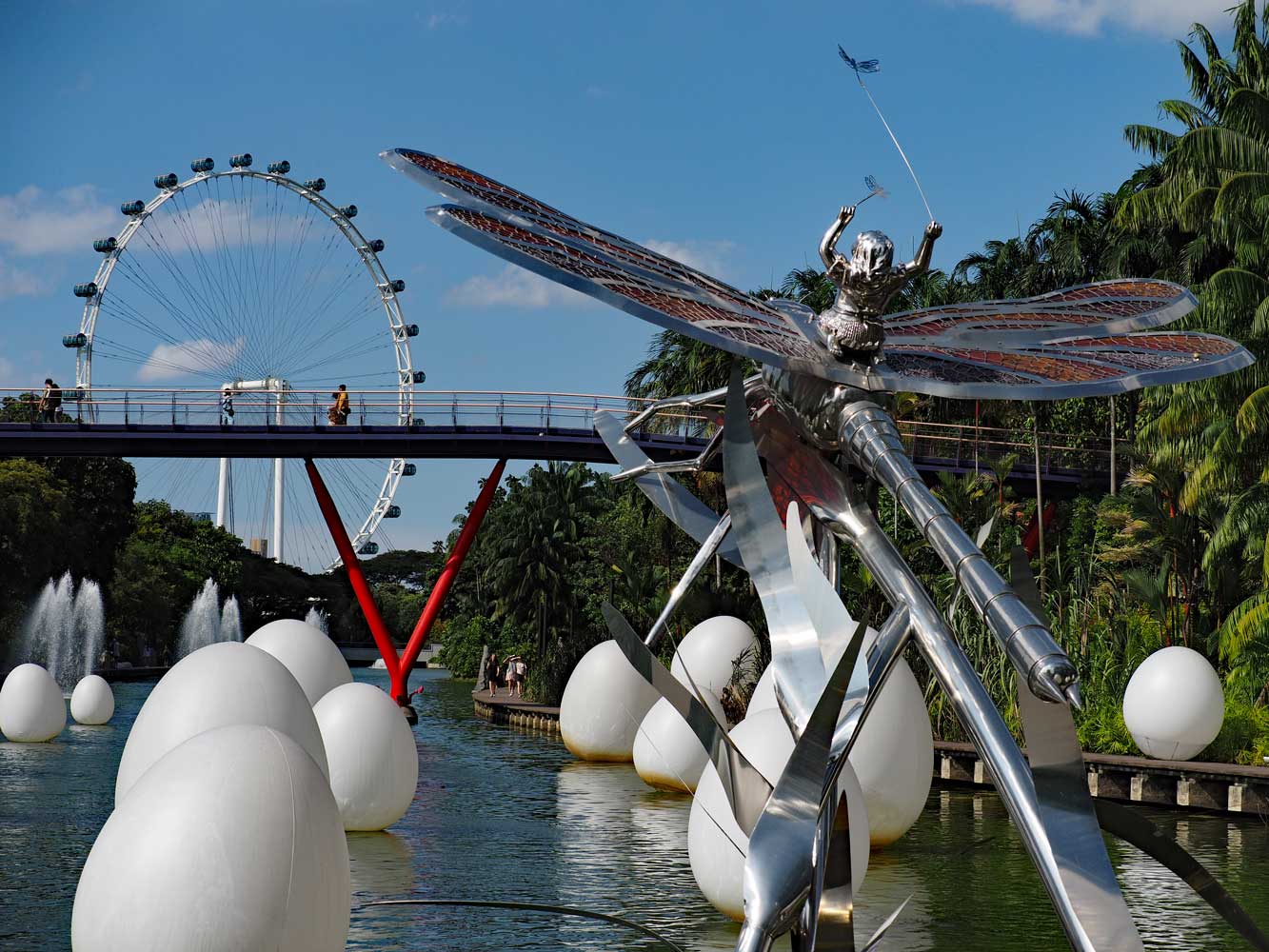
A little girl soars on a dragonfly above Dragonfly Lake.
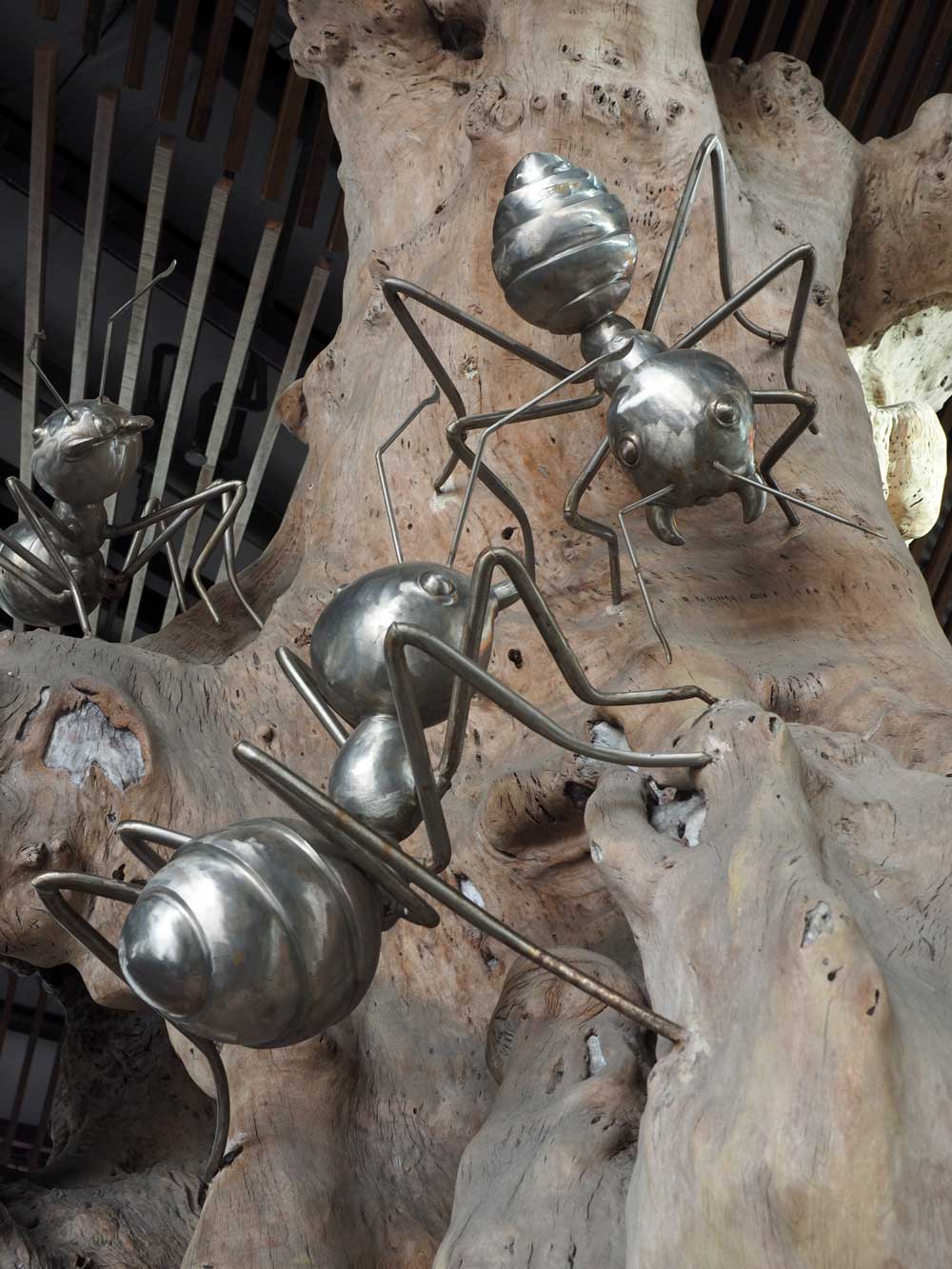
Ants on Trees by Eng Siak Loy
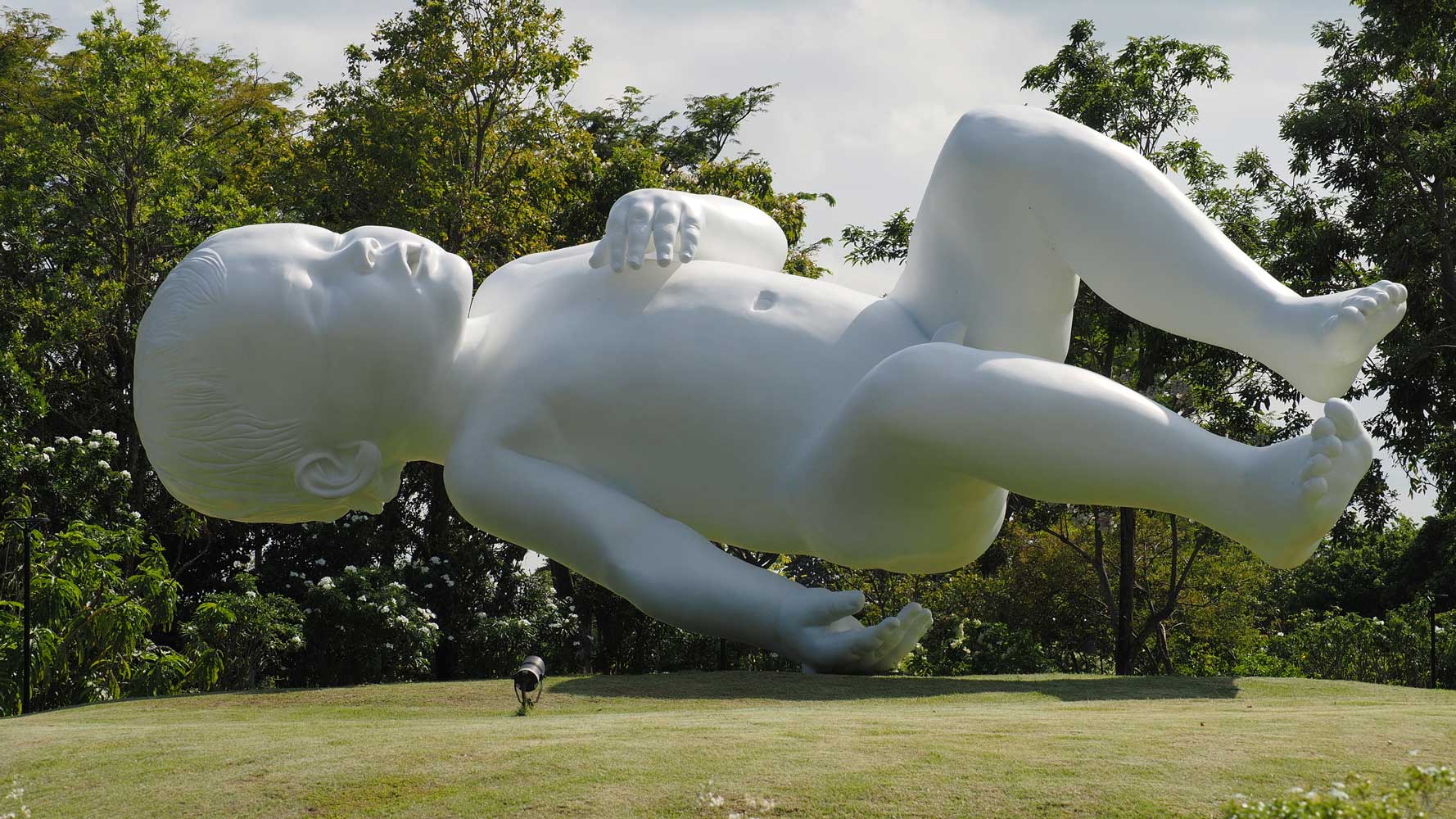
Planet by Marc Quinn depicts the artist’s infant son Lucas.
After a good lunch of an Indian vegetarian thali at one of the food stalls, I entered the Cloud Forest, the most impressive exhibit in the impressive gardens. The first thing I noticed was the cool air because this greenhouse encloses 35-meter-high artificial mountain covered in plant life of the Tropical Montane region. The second thing I noticed is the waterfall pouring off from the summit. I walked the trail around the mountain’s base, admiring the flowers, ferns, and greenery. ‘Orchids of the Amazon,’ a special exhibit, contained a shaded passageway with showy blooms from tiny to huge. Next I took an elevator and stairs to the ‘Lost World’ on the summit which has a pond, pitcher plants, and other exotic flora. A path gradually spiraled down, alternating between passageways inside the mountain and dramatic suspended walkways high above the ground. Late-afternoon light brought vibrant warm colors to the mountain. Views through the greenhouse panes took in downtown forests of skyscrapers, Marina Bay, and the many cargo ships anchored in Singapore Strait. Giant cave stalactites filled one chamber, though I would have preferred that these had stayed in their natural homes and artificial cave features used instead. Other rooms in the mountain offered nature exhibits and videos.
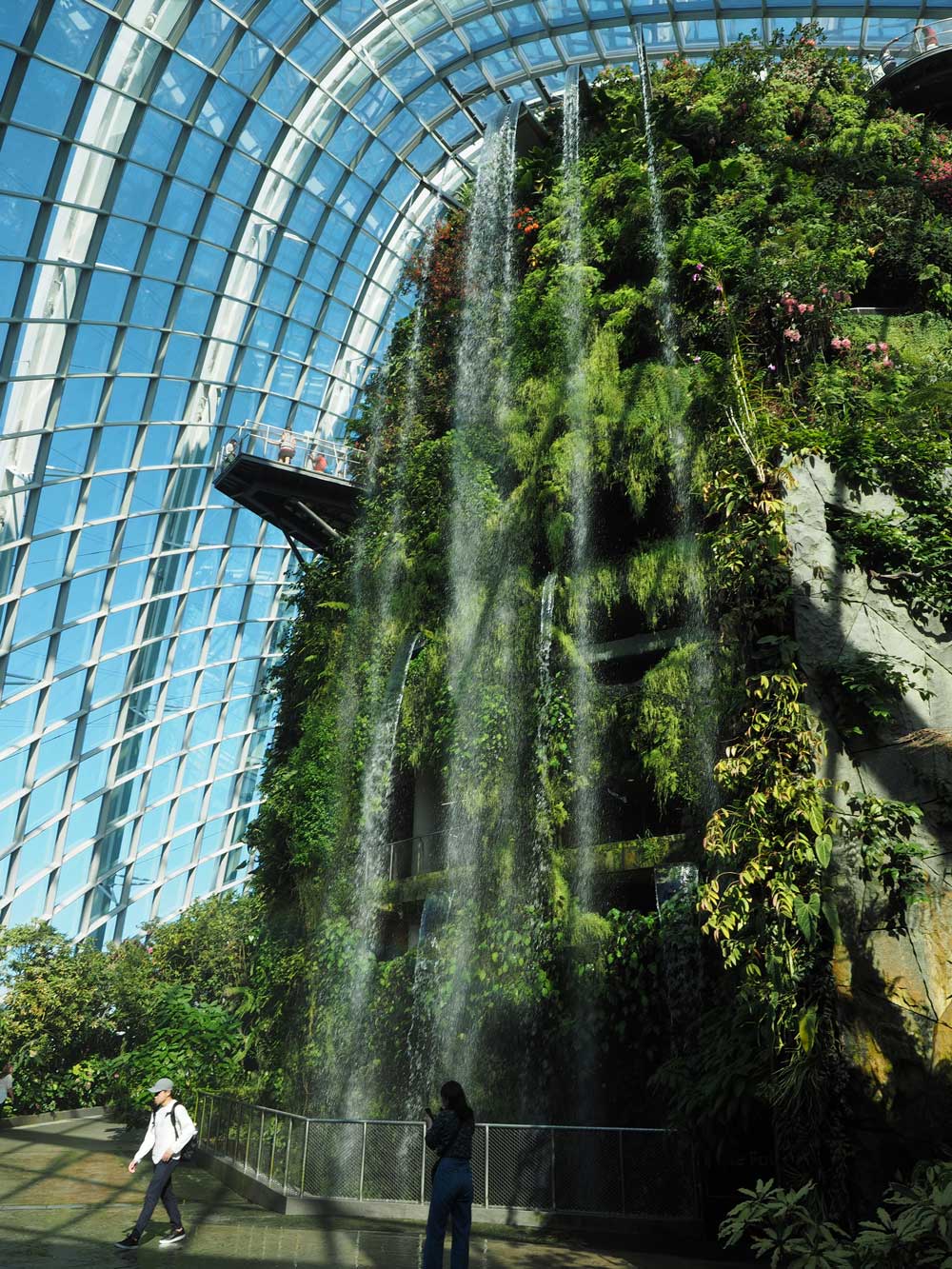
This waterfall greets you near the entrance to the Cloud Forest.
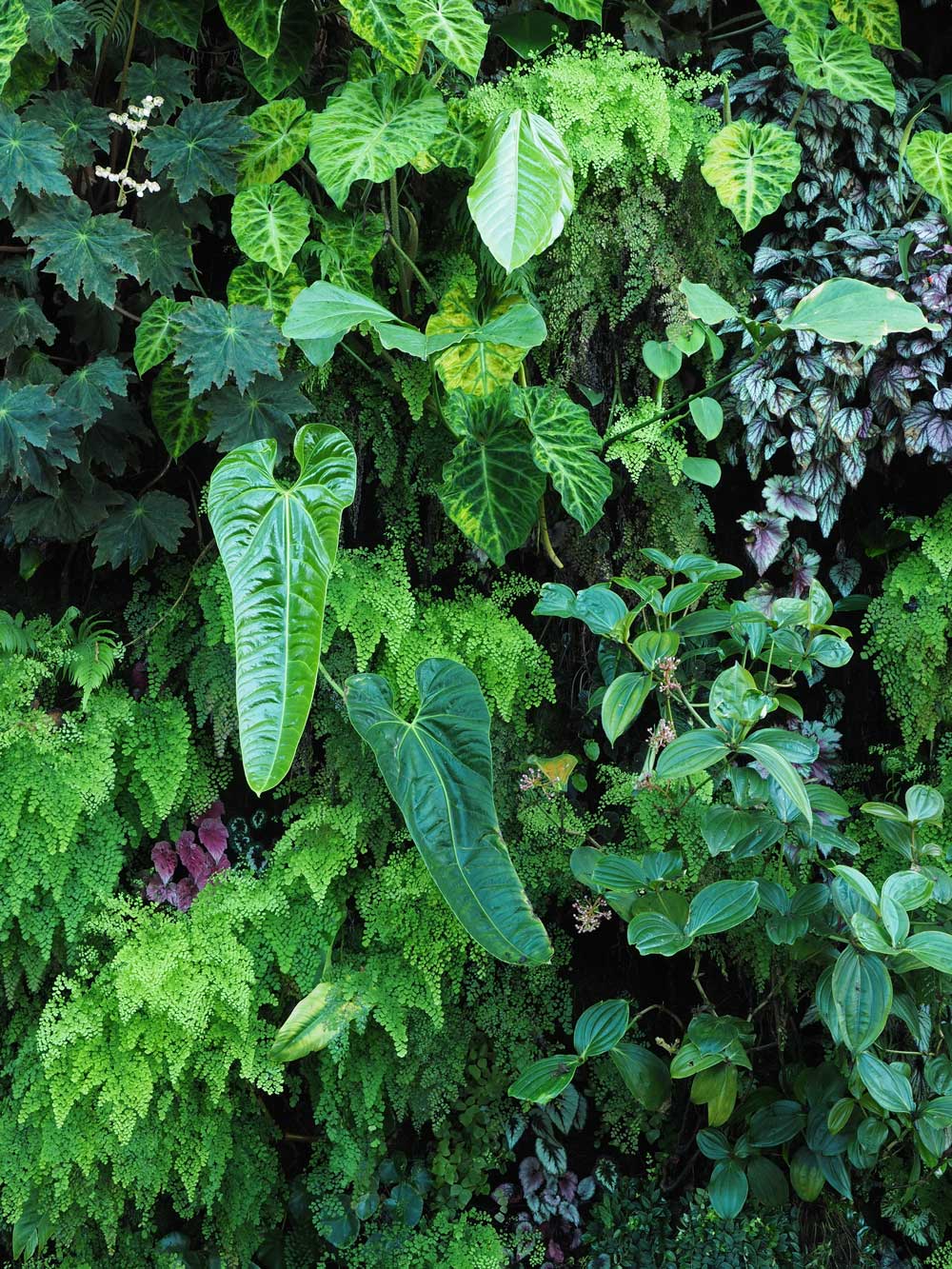
Lush tropical greenery clings to the mountain.
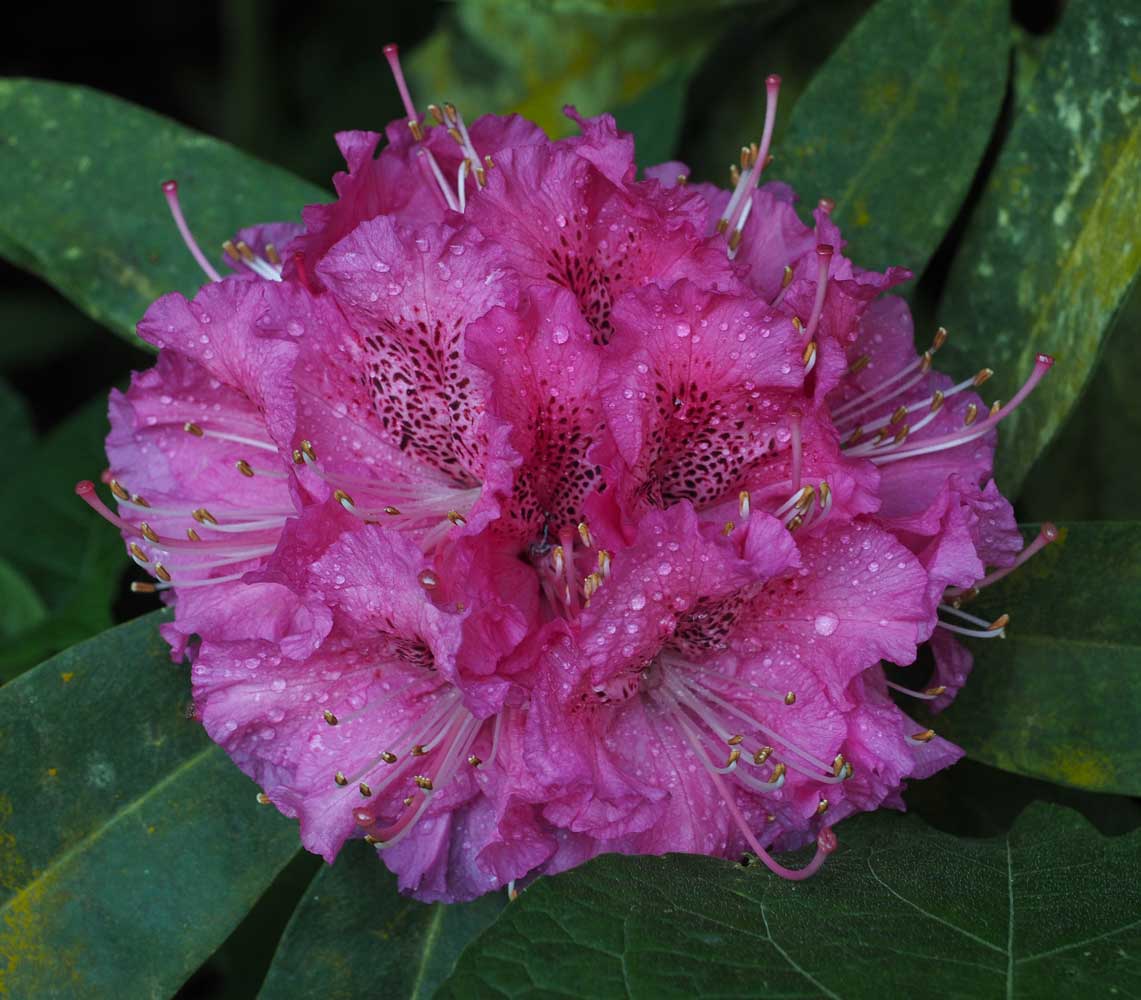
A rhododendron shows off.

And in a golden hue
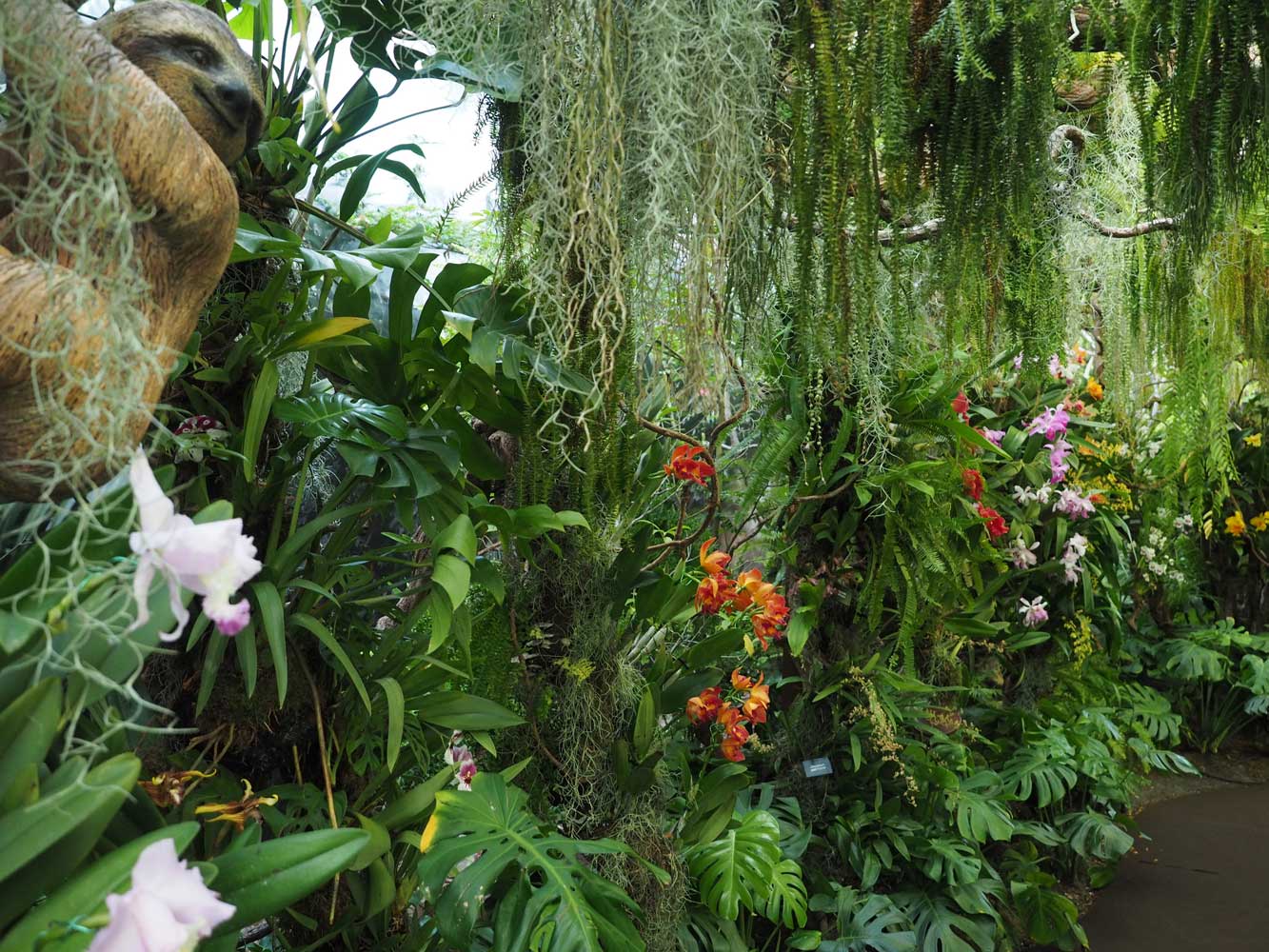
Orchids of the Amazon, a temporary exhibit
Watch out for the three-toed
sloth sculpture on upper left.

At the base of the mountain
The weathered wood totems come from East
Timor.
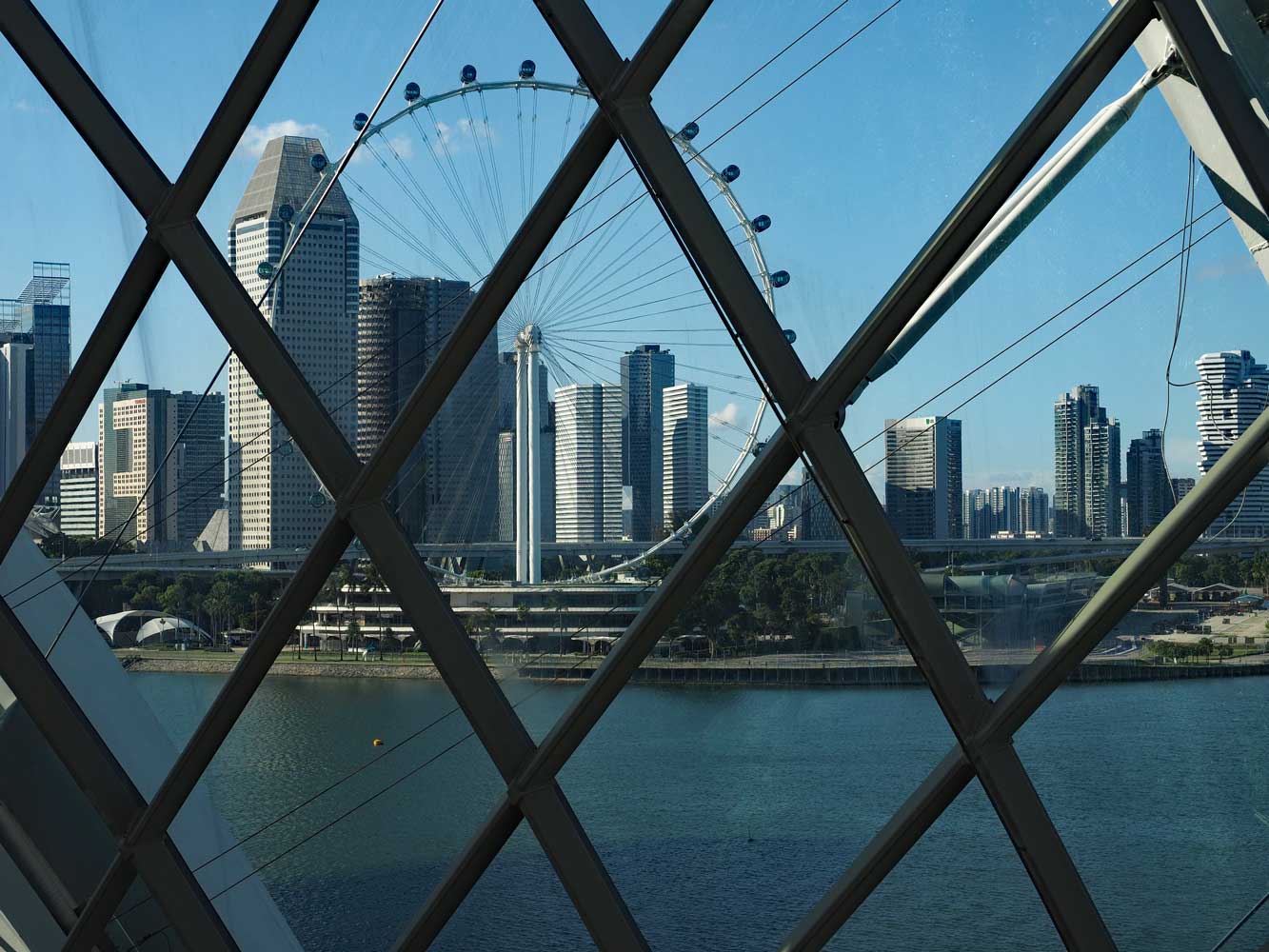
View across the bay
The 165-meter-tall Ferris wheel ‘Singapore Flyer’ wasn’t running during my visit
to Singapore.

The bay forms a backdrop to the waterfall and its fuchsia
flowers.

Lego blocks form a rafflesia and pitcher plants in the middle of the ‘Lost
World.’
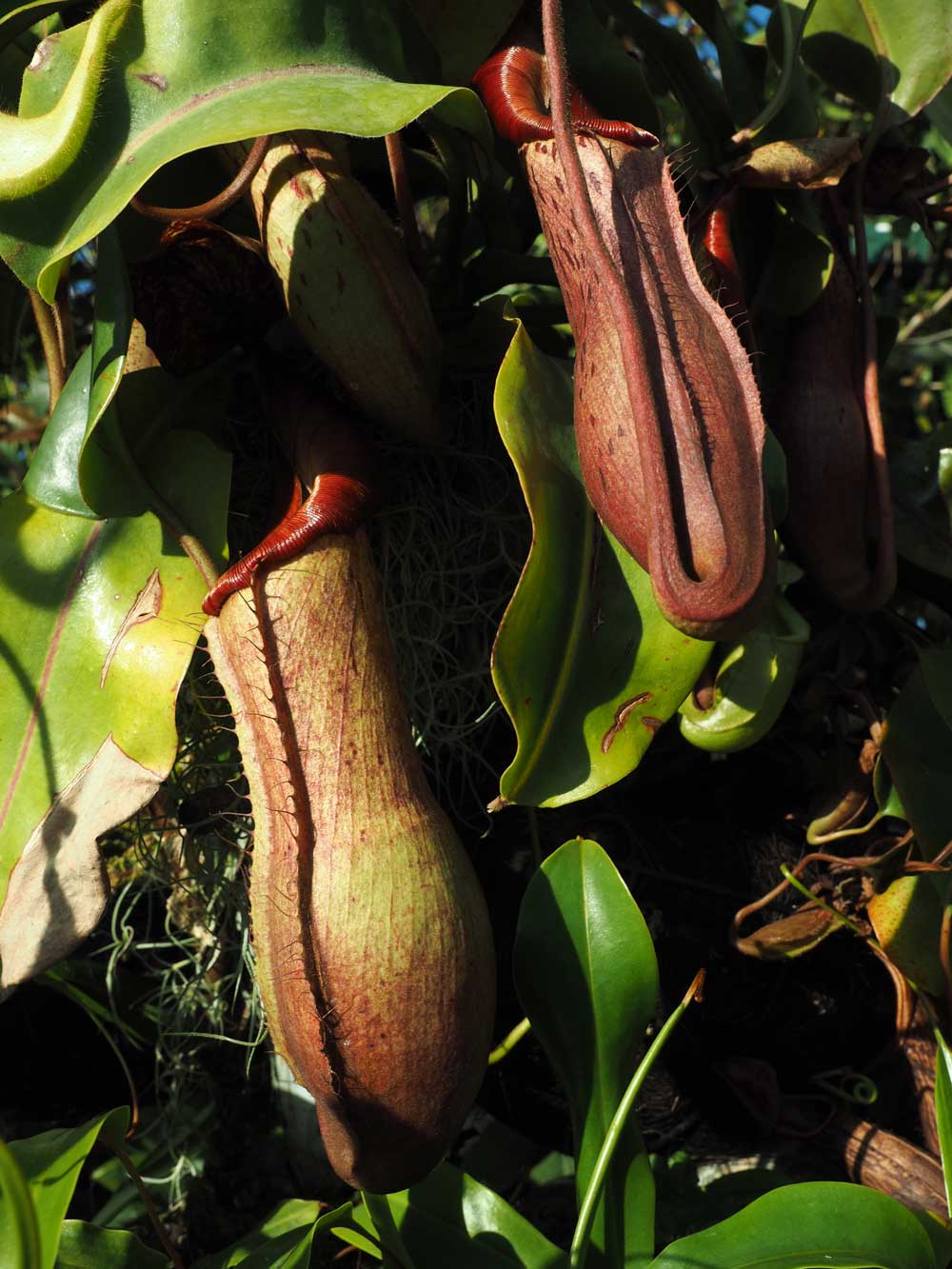
The real thing: pitcher plants in the ‘Lost World’

Exhuberant blooms of the ‘Lost World’
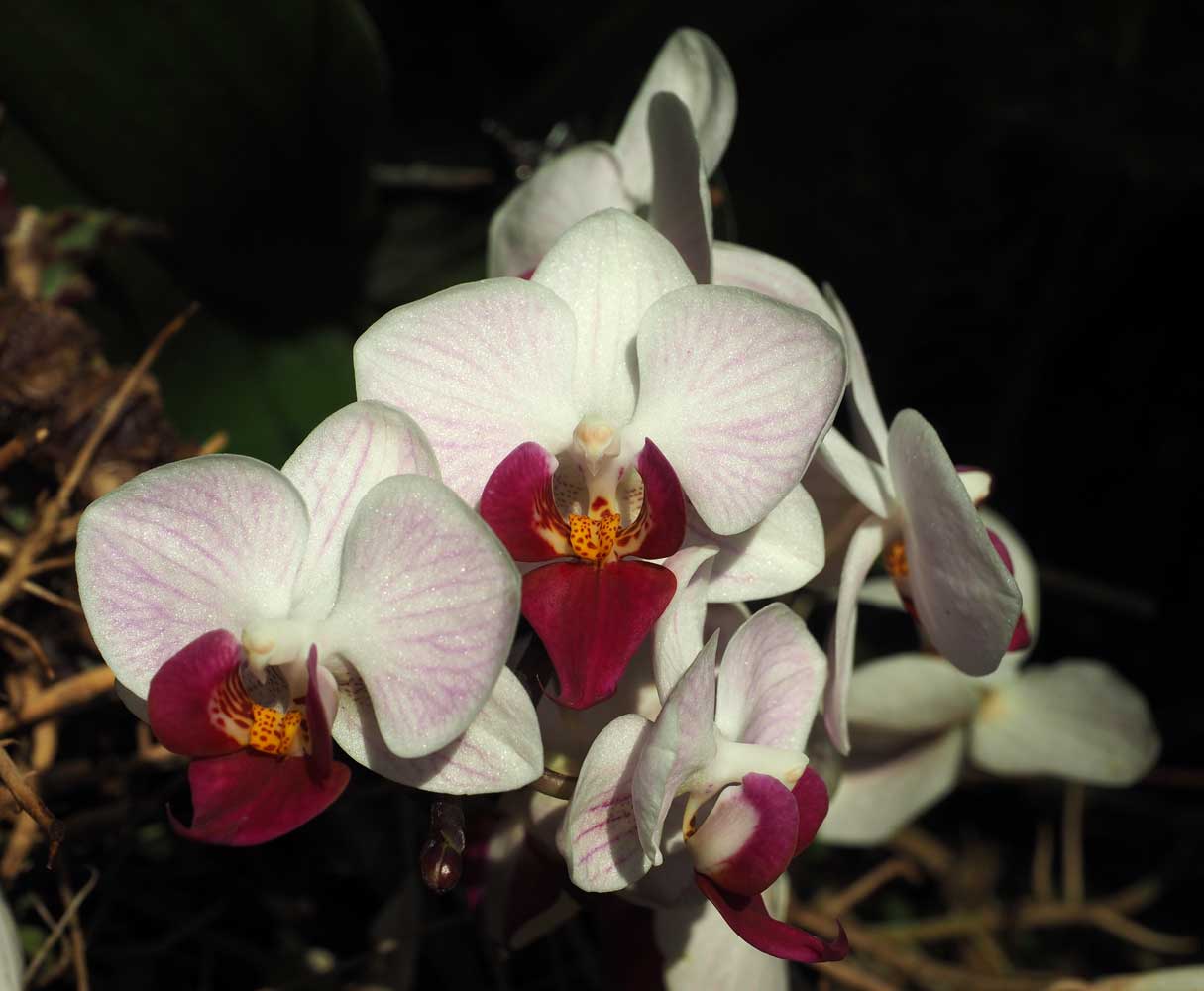
And showy orchids
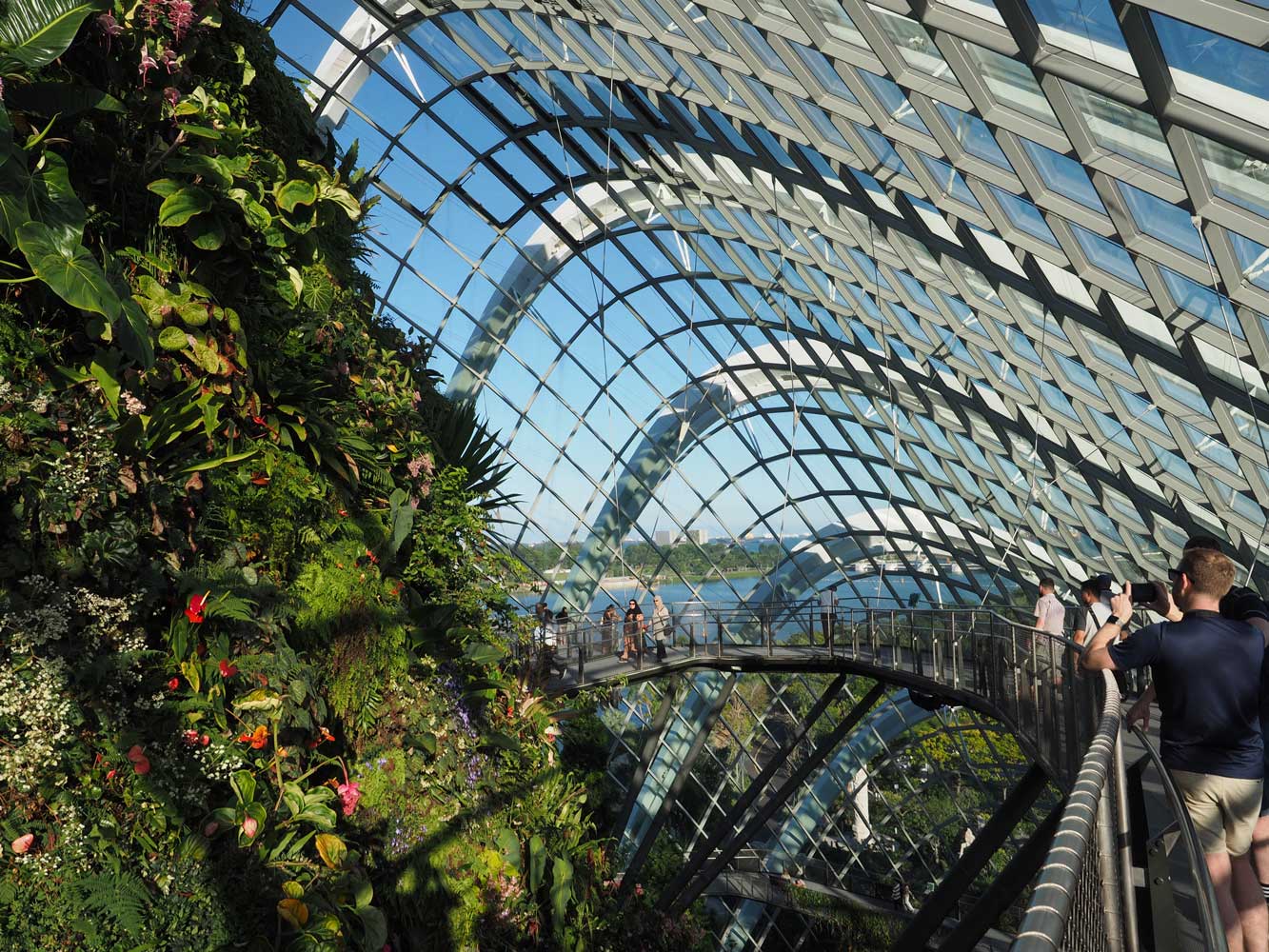
Strolling along the lofty walkway

With delicate flowers along the way
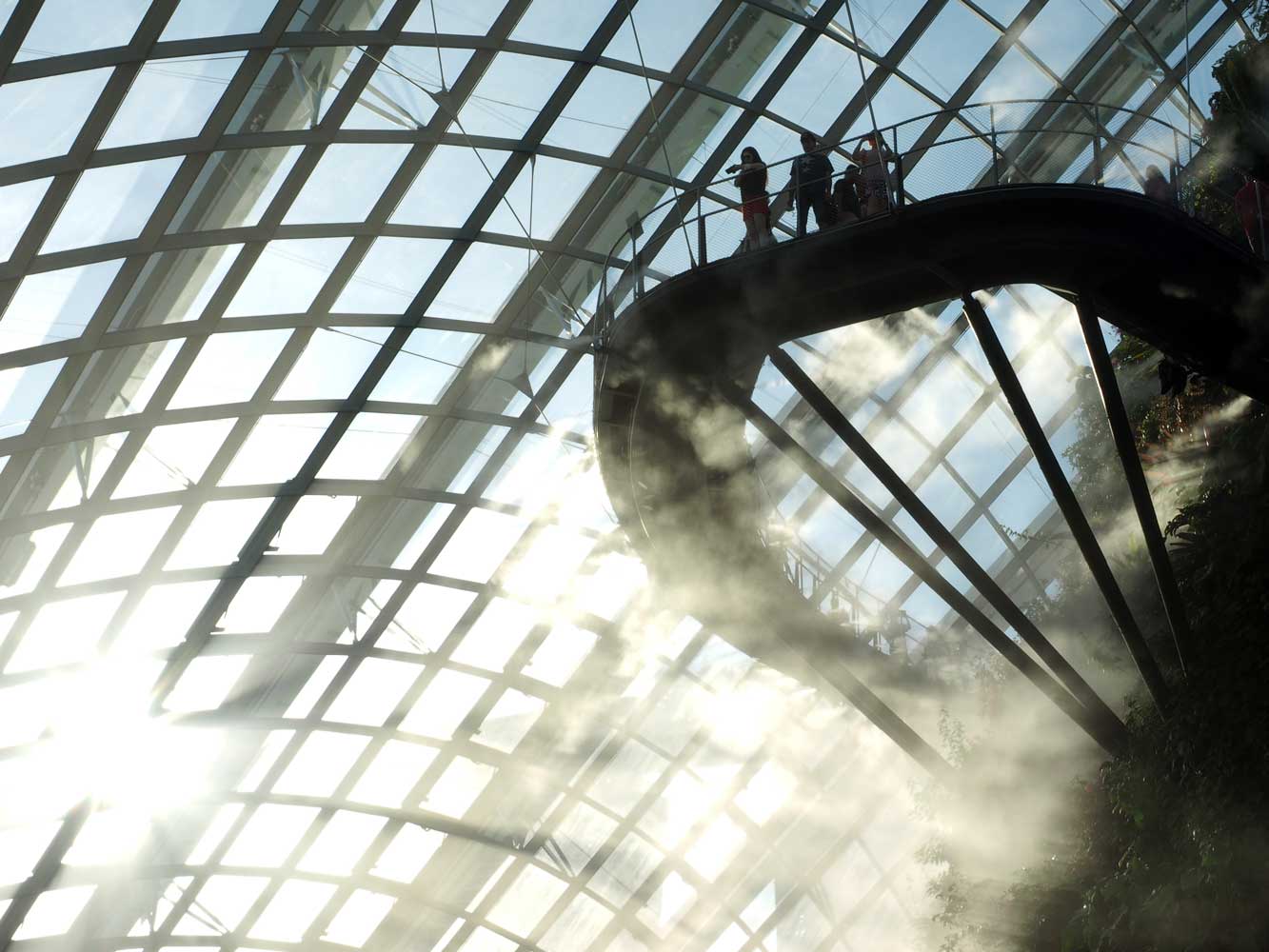
Mist envelops the mountain.
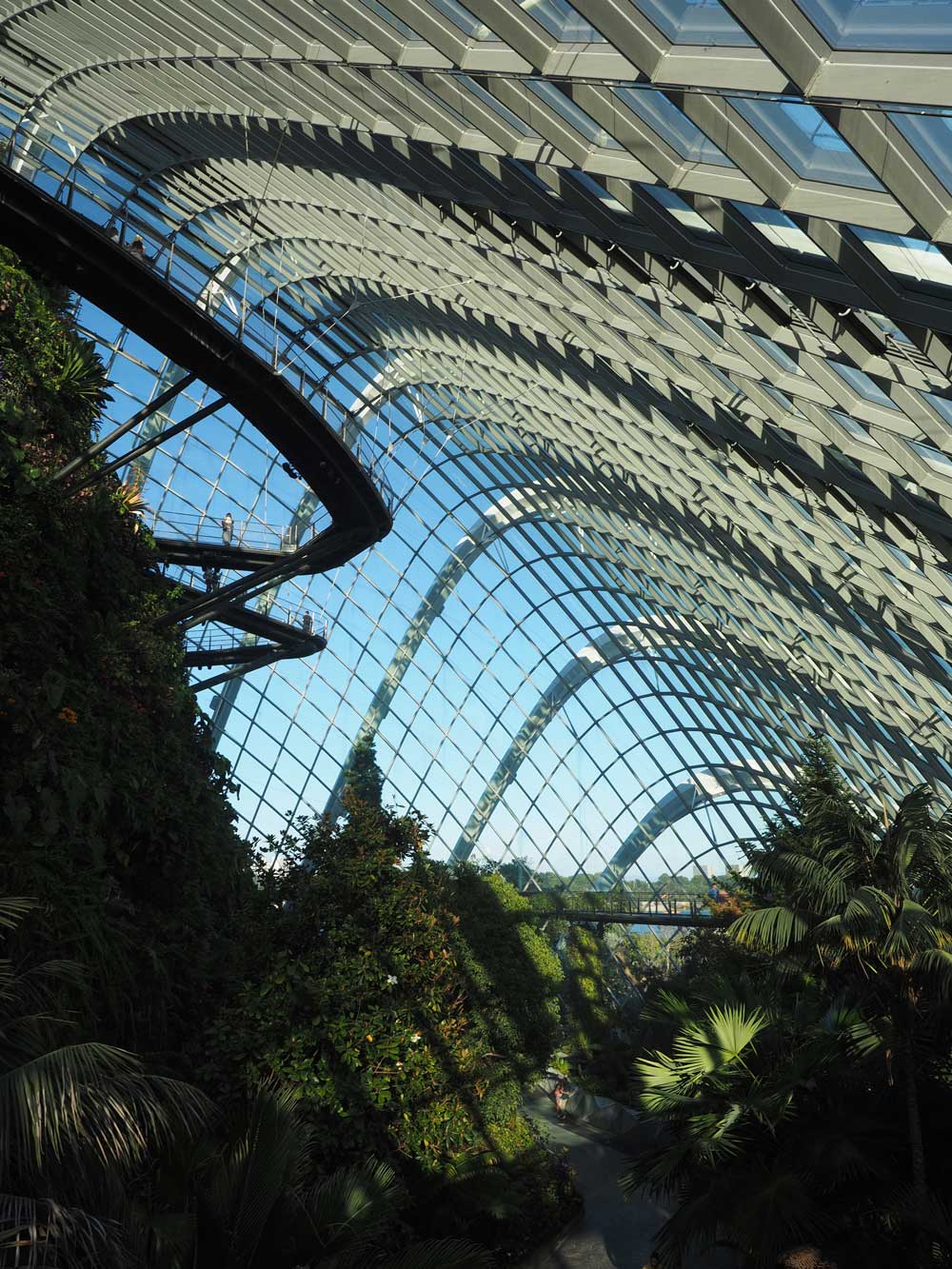
We’re on the lower walkway now.
Next door I entered the even larger Flower Dome, a greenhouse filled on several levels with towering cactus, massive baobabs, thousand-year-old olive trees, and other plant life of the world’s Mediterranean regions along, of course, with lots of flowers. While I wandered among the exotic flora here, the sun set and the lights came on, so I got to see the plant communities under both sunlight and artificial lighting. (The greenhouses stay open until 9 p.m.)
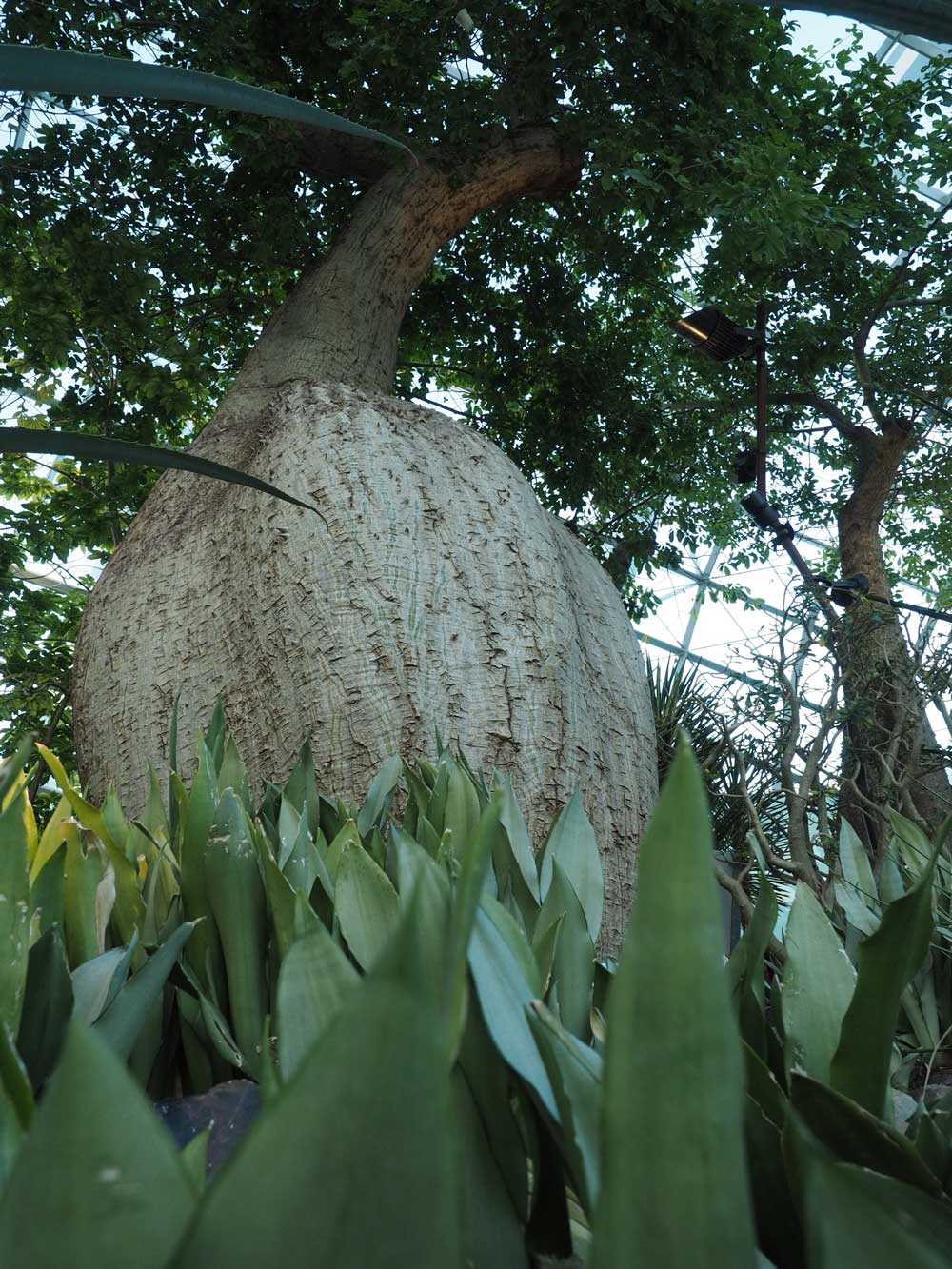
The bottle tree (Ceiba chodatii)
The Argentinian Palo Borracho
or drunken tree belongs to the cotton family (Malvaceae) and grows in
the wild in Argentinia, Bolivia, and Paraguay.
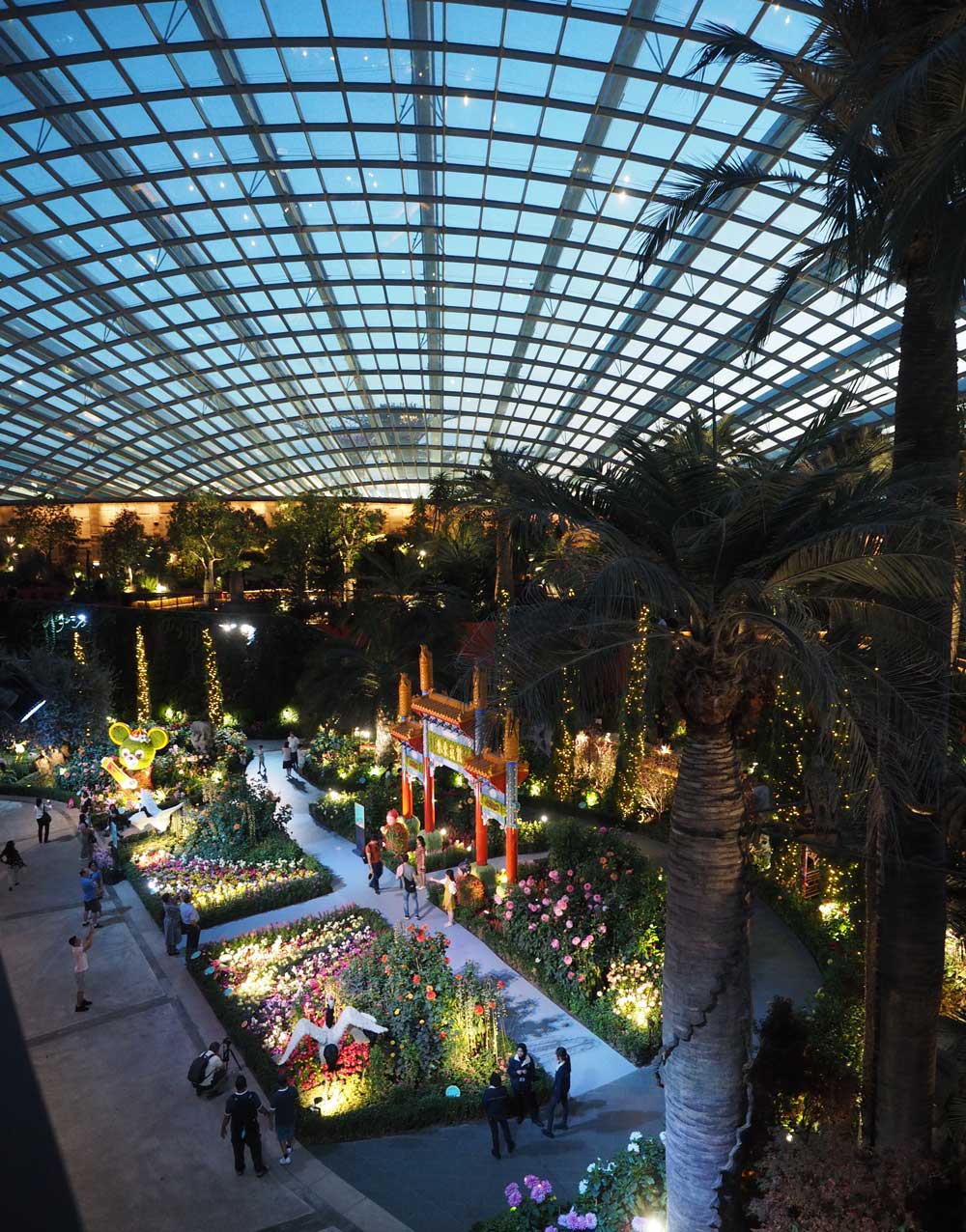
Lower level of the Flower Dome

Archway ‘Auspicious Omens’
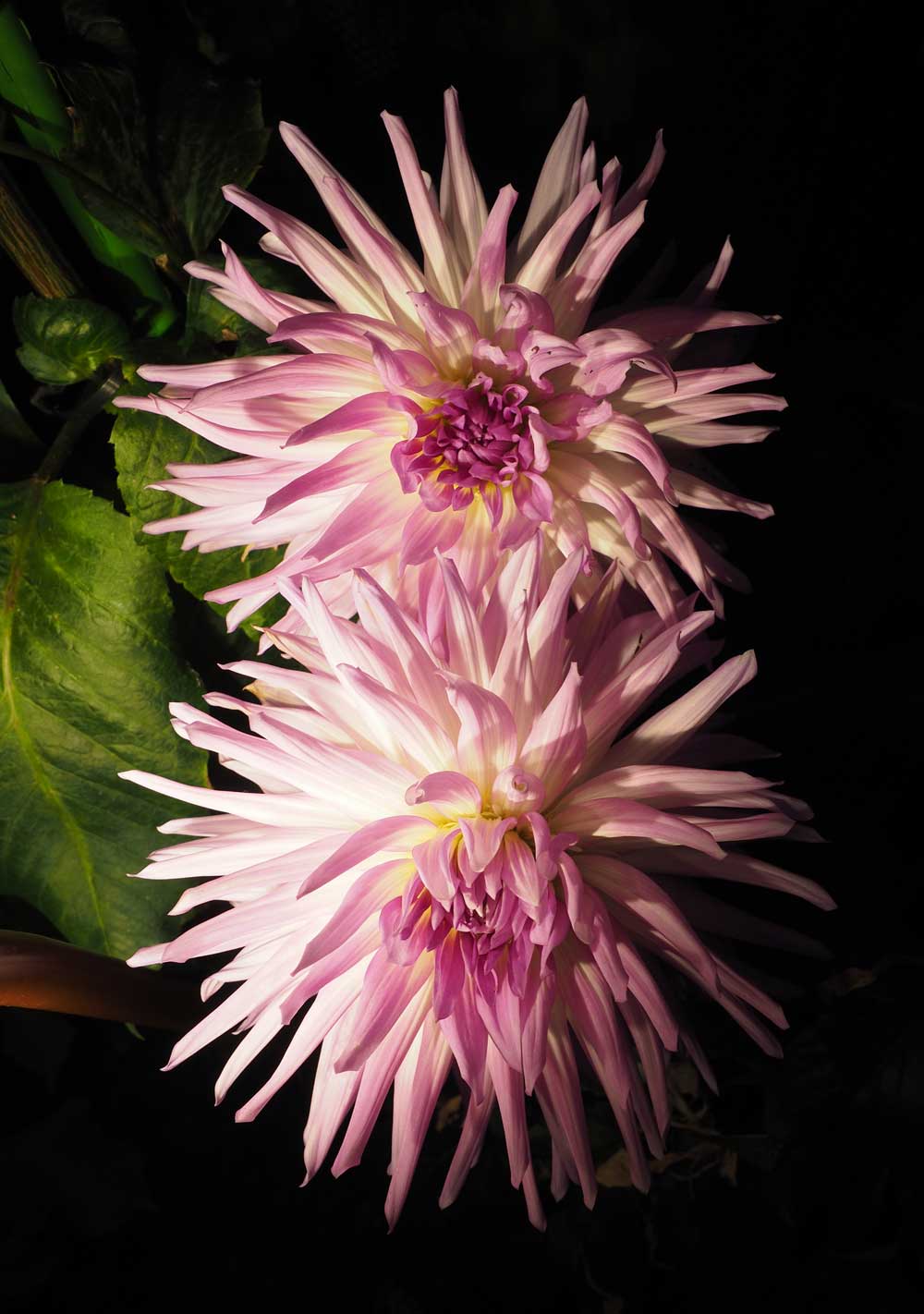
Chrysanthemums are flowering plants of the genus Chrysanthemum in
the family Asteraceae.
They’re native to Asia and northeastern
Europe, with most species originating in East Asia, especially in China.
Countless horticultural varieties and cultivars exist.
Outside, I swung by the Supertree Grove for the Sound-and-Light Show, very spectacular with thousands of colored lights on the trees constantly changing and moving to the sounds of famous opera arias.
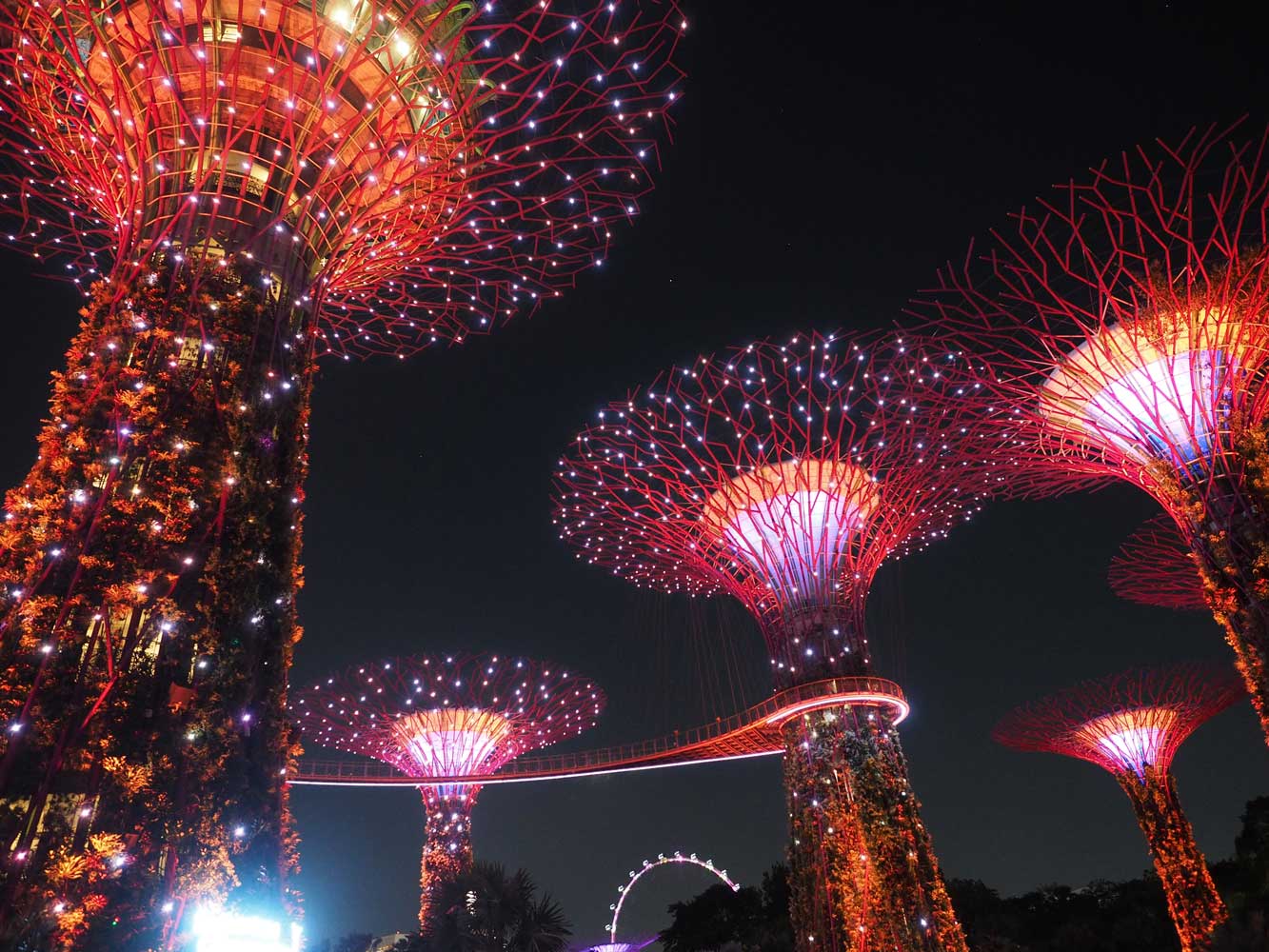
Lights twinkled and colors changed during the performance.
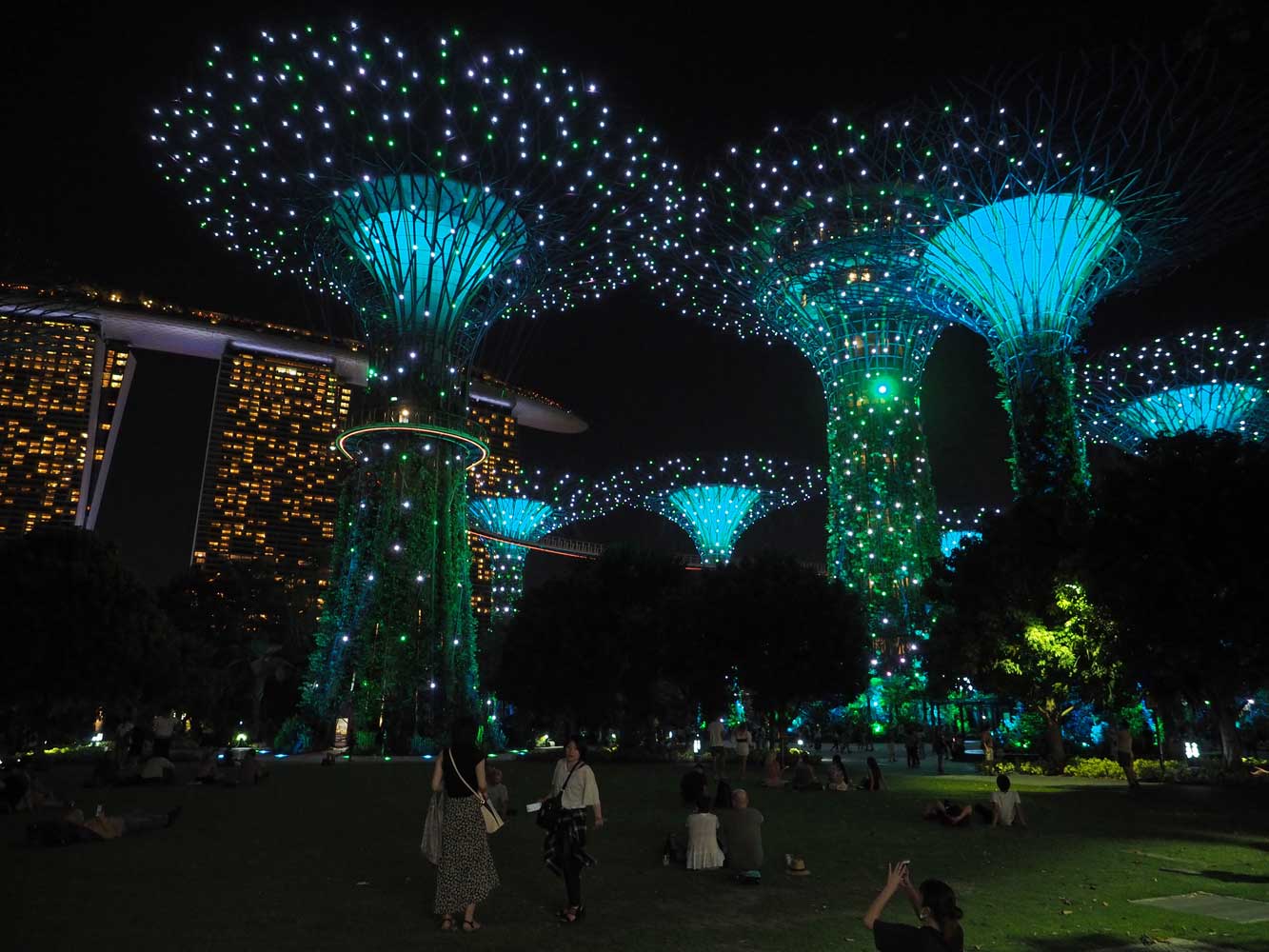
The show dazzled! Five days from now I will see it from atop Marina Bay
Sands in the background.
I then hiked around the gardens to experience them at night. Hundreds of giant inflated white balls in a section of Dragonfly Lake had transformed with internal illumination into a mesmerizing light show with waves of colored lights seemingly washing through them.
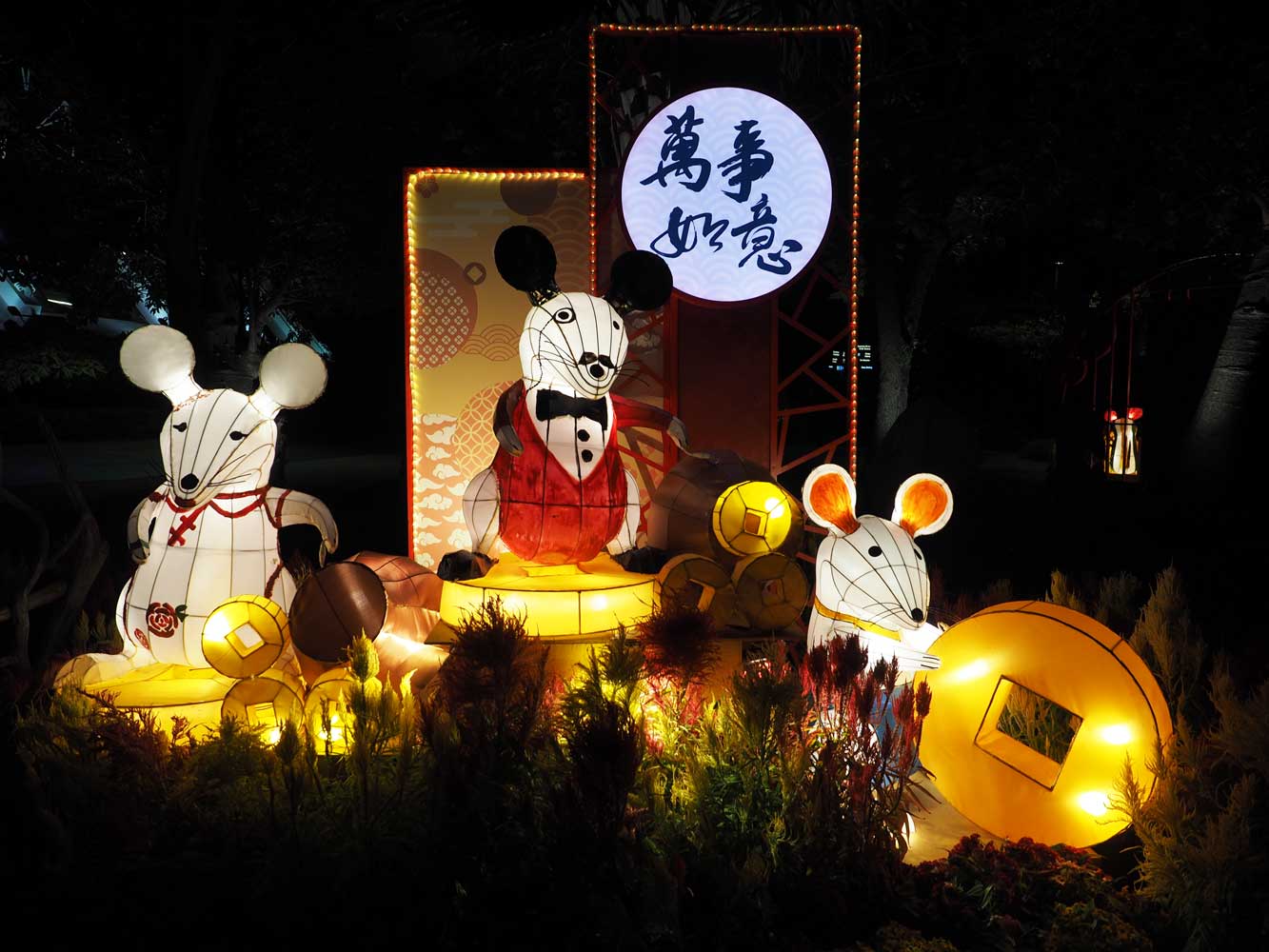
Welcome to the Year of the Rat!
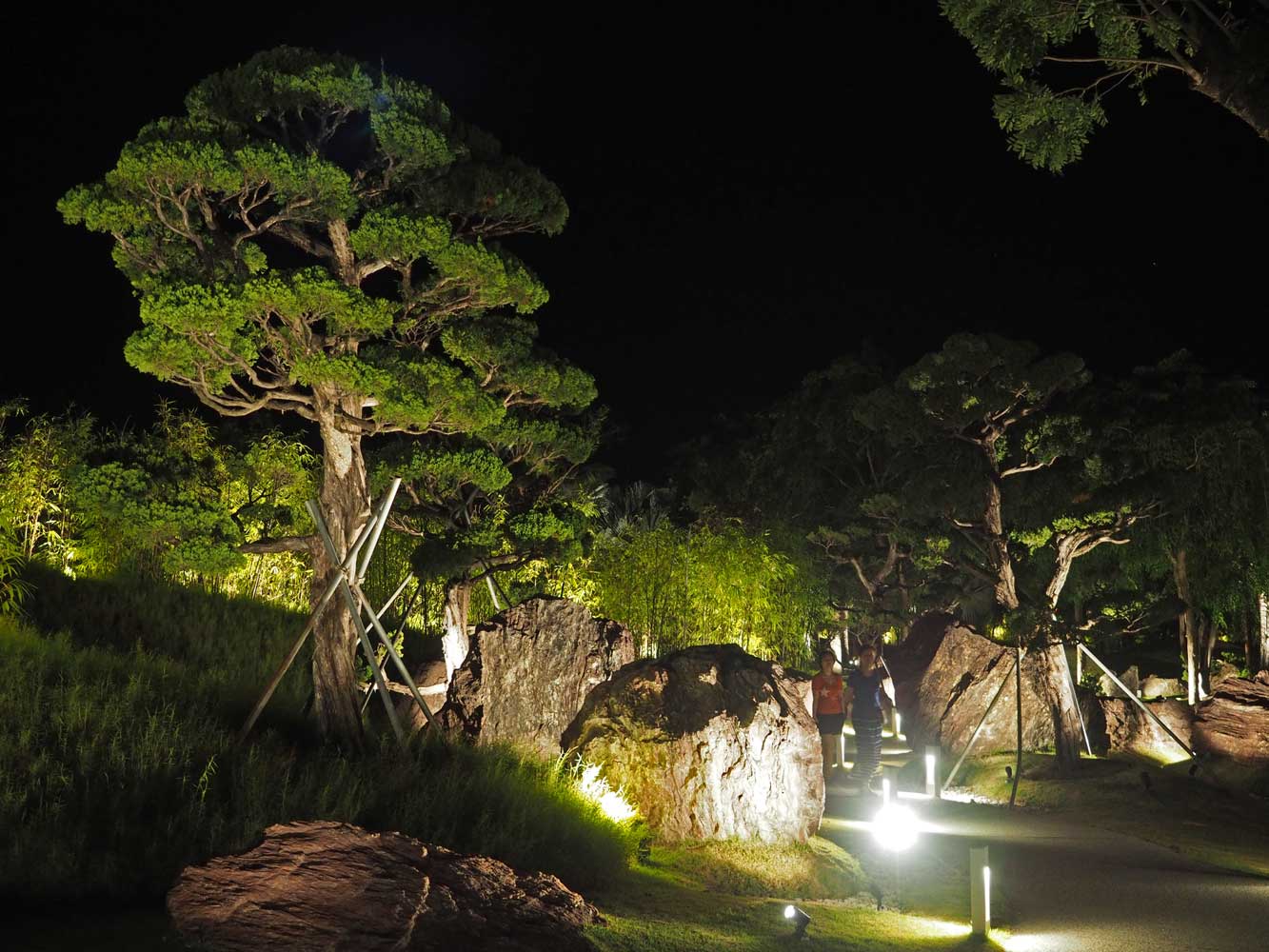
The gardens have a very different appearance at night!
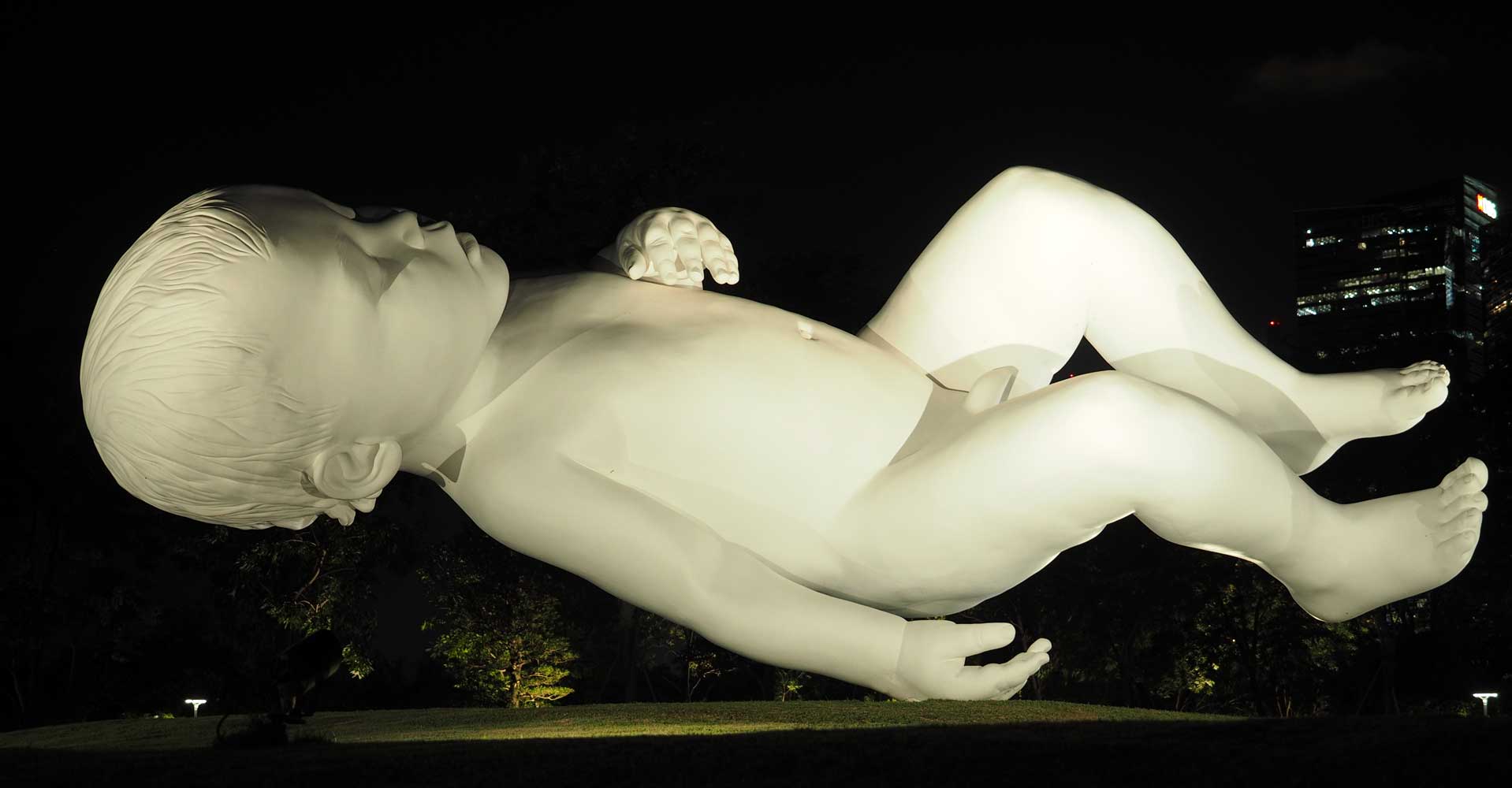
Planet
by Marc Quinn under the lights
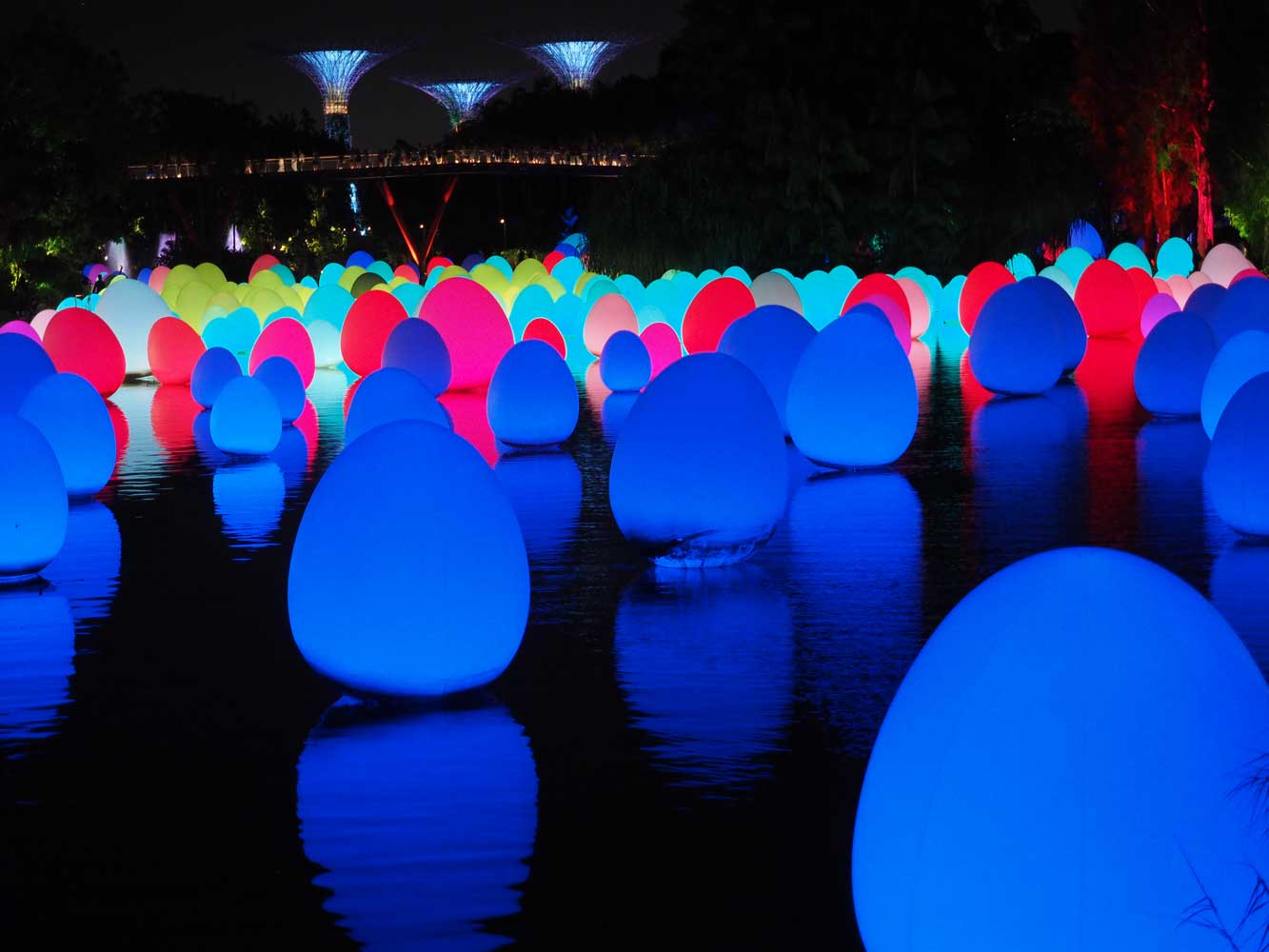
Colors seem to flow across the giant eggs.
In the background you can see
Dragonfly Bridge and the trio of Supertrees at Silver Garden.
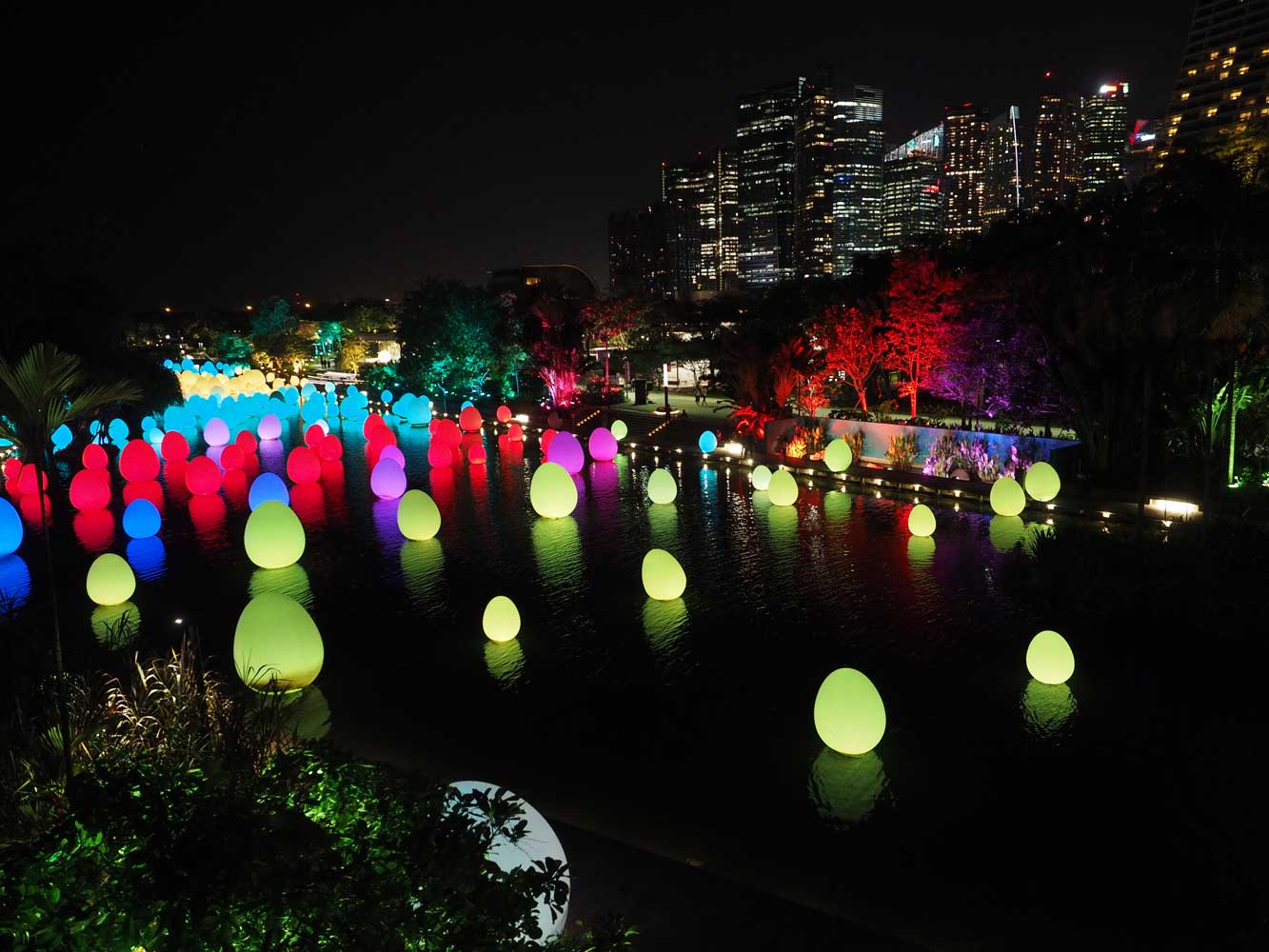
View from Dragonfly Bridge
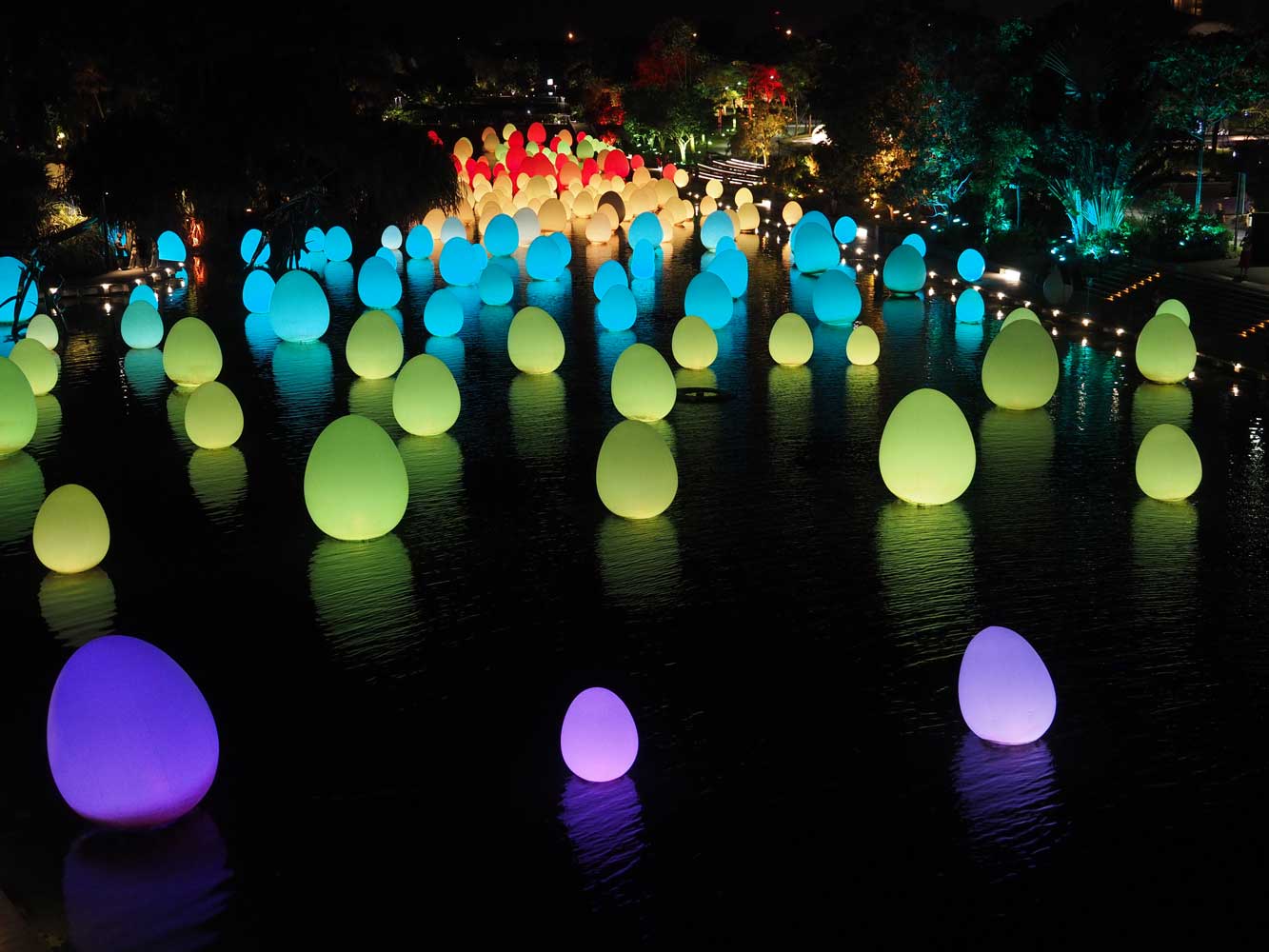
And a couple minutes later
Afterward I easily caught a Grab taxi back to my room. I highly recommend a visit to Gardens by the Bay! It has free admission to the outside exhibits, but you can pay a lot to go inside anything. I forked over S$28 to visit the two greenhouses, but skipped the Floral Fantasy (S$20; floral art and a 4D ride), the Skyway elevated path in the Supertrees (S$8), and the Supertree Observatory (S$14).
On to Singapore—Part 2: Little India, Art, and Views
Back to beginning of “Backpacking 2020: India, Singapore, and Philippines”